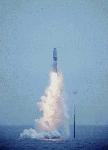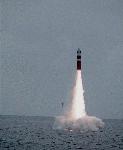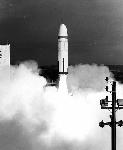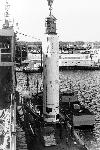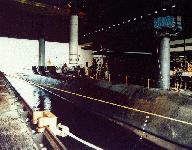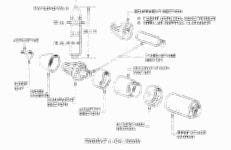Trident I C-4 FBM / SLBM
 The TRIDENT I (C-4) is a submarine-launched ballistic missile (SLBM) developed to
replace the Poseidon missile in existing strategic missile submarines and to arm the OHIO
class SSBNs. Today it is carried by the eight OHIO class submarines operating in the
Pacific. The C-4 missile was first deployed in 1979.
The TRIDENT I (C-4) is a submarine-launched ballistic missile (SLBM) developed to
replace the Poseidon missile in existing strategic missile submarines and to arm the OHIO
class SSBNs. Today it is carried by the eight OHIO class submarines operating in the
Pacific. The C-4 missile was first deployed in 1979.
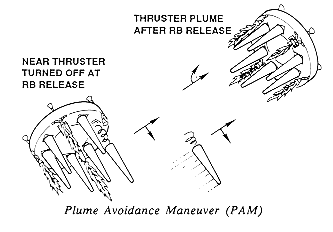

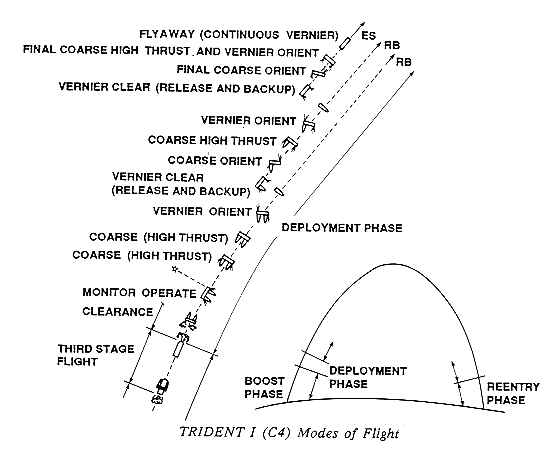

To achieve a 4000 nm range [ versus the 2500 nm range of the POSEIDON C3] the Trident I (C4) is a three-stage solid-propellant missile with basically the same envelope dimension as a C3 (e.g., 34.1 ft in length and 74 in. in diameter), limited by the space available in a POSEIDON SSBN launch tube. There was a weight increase to approximately 73,000 lb. There was an increase in the C4's Nose Fairing [NF] envelope, compared to C3, to allow introduction of a solid propellant Third Stage [TS] booster in the center of the ES/NF. Each of the three stages has a boost rocket motor with advanced propellants, improved case materials, and a single lightweight movable nozzle with a TVC system of lightweight gas-hydraulic design.
Boost velocity control is achieved by burning all boost propulsion stages to burnout, shaping the trajectory to use all the energy, without thrust termination. This method is termed generalized energy management steering (GEMS). The ES is powered by a solid-propellant PBCS. Miniaturizing and repackaging missile electronic components also contributed to reduced package sizes, weights, and calibration, thereby allowing more volume for propulsion.
In the missile electronics, improved system accuracy was achieved by incorporating a stellar-inertial guidance concept, by improving the Navigation and Fire Control systems, and by more accurate control of reentry vehicle separation. Inert weights were reduced with structures fabricated from composite graphite-epoxy materials which represent 40 percent weight saving compared to similar structures made from aluminum.
The largest contribution to attaining the range increase goal came from incorporating a third boost propulsion stage. To fit within the same cylinder as the POSEIDON this third stage motor was to be mounted in the center of the post-boost vehicle with the reentry vehicles carried around the third stage.
The strategy adopted to achieve the remainder of the range goal was to pursue range gaining technologies in the following general ways all in parallel: decrease inert weight throughout the entire missile, increase the volume available for propulsive energy, and increase the usable energy per unit volume. This strategy resulted in efforts directed to developing a smaller and lighter guidance system, lightweight missile structures, low volume and lightweight electrical and electronic components, smaller or lighter post-boost control system, an aerospike to reduce boost phase aerodynamic drag and, most importantly, higher performance rocket motors. In order to withstand reentry heating at long ranges and higher ballistic coefficients, new protection materials needed to be developed for the reentry vehicles.
The range extension dictates for weight reduction were complicated by the unique reentry vehicle placement around the third stage which made thrust termination difficult to engineer. And in introducing a third stage of boost propulsion and making maximum use of the available launch tube volume, the missile nose shape became so much blunter that aerodynamic drag during boost could have significantly detracted from meeting the range increase goal. It therefore became important to reduce boost phase drag.
A deployable aerospike, extended shortly after launch, was incorporated to reduce the frontal drag of the C4 NF by approximately 50 percent. The aerospike is self-contained and requires no functional interface input from other missile subsystems. A small solid propellant gas generator provides the energy to extend and lock the aerospike into position. Its ignition is triggered by acceleration of the missile on ejection from the submarine. This unique feature, utilized for the first time on a ballistic missile, was adopted to offset the aerodynamic drag and performance degradation of the unusually blunt nose fairing. A concentrated effort to reduce the Mk 4 reentry vehicle weight as much as possible was also conducted.
The remaining major technical challenge to achieving the range increase objective was the development of solid propellant rocket motors incorporating technological advancements in both propellants and inert components. In recognition of the importance in the throat, carbon-carbon entrance and exit segments and either carbon or graphite cloth phenolic in other areas. An omnidirectional flexible joint enables movement required for thrust vector control.
Reentry system design objectives included more than doubling the maximum range at which the reentry vehicle with its high ballistic coefficient (weight-to-drag ratio) could reliably withstand reentry heating without significant weight increase. The major technical issues involved in meeting this objective were those of materials technology. Several alternative design concepts for the nosetip, heatshield, and substrate materials were examined in parallel during the early stages of development. A highly successful supplemental flight test program carried out in 1974 and1975 with surplus Atlas and Minuteman missiles helped in the early selection of materials and design concepts.
The reentry body has a tape-wrapped carbon phenolic (TWCP) heatshield bonded to a thin-wall aluminum substrate for the shell and a graphite nosetip. The TWCP is similar to material previously used by the Air Force for reentry bodies, but with the carbon particles eliminated. It is made from a carbonized rayon cloth, wrapped on a mandrel, and cured in a female mold. The TWCP ablates during a reentry, leaving at least a minimum amount of cool material intact to impact. The graphite is a fine-grain graphite, especially developed for strong and uniform properties. So critical was graphite quality, and so difficult to inspect the end product, that a separate factory, a computer controlled facility, was built for its exclusive production where processes could be completed controlled.
Background
Lockheed commenced a TRIDENT I (C4) Advanced Development Program on 15 November 1971, which was the start date for contract N00030-72-C-0108.The IOC of the C4 was established as CY 1979. The SECDEF on 23 December 1971 approved Navy Program Budget Decision #317 to increase ULMS budget funding to permit acceleration of the program calling for deployment of a new class of SSBNs capable of carrying the 4000 nm TRIDENT I missile and, later, the 6000 nm TRIDENT II missile. On 1 November 1973, Lockheed commenced the TRIDENT I (C4) Missile contract for missile system development plus the production of the first missiles including reentry vehicle shells. The contract provided for support equipment and technical services to outfit and support operation of TRIDENT I and backfit submarines, SWFPAC, POMFLANT, and training facilities.
The major engineering challenges of the TRIDENT missile development, which required innovation as well as state-of-the-art advances, derived from the goals of doubling the missile range in the same volume and weight while keeping the already surprisingly good accuracy at this doubled range. Improving the accuracy involved navigation and fire control improvements as well as missile and guidance. In addition to these technological challenges, there were equally important design constraints derived from cost and reliability goals. Development costs were constrained in a period when inflation was high, and different in the various segments of the economy, while inventories were generally very low and lead times long. Production cost was an additional major design consideration and reliability (hence operational dependability) was, as always, given top priority.
The accuracy of the new missile system, to maintain effectiveness, was to be equivalent at 4000 nm to that of the POSEIDON C-3 at 2000 nm. To gain the increased full payload range, it was necessary to give up some of the maximum possible ABM exchange ratio which would only be of value should the then proposed ABM Treaty be abrogated. As a hedge against such a contingency, advanced development of a maneuvering, evader reentry vehicle capable of being carried by the missile was included in the program.This provided reasonable assurance that a possible later decision to initiate engineering development of such a system in response to Soviet ABM deployment would not require reengineering of the weapon system. Six flight tests from 6 March 1974 to 13 November 1975 developed the new reentry vehicle (Mk 4) for C4, along with a Mk 500 maneuvering reentry vehicle, demonstrating the feasibility of the concept and its compatibility with the TRIDENT missile system.
The C4 missile development flight test program commenced on 18 January 1977 with the successful launching of C4X-1 from the flat pad (25C) at Cape Kennedy. This was followed by 17 additional C4X launches from pad 25C. Of these 18 flights, 15 were successful, 1 was a partial success, 1 was a failure and1 was a no test (due to ground support equipment error). The C4X program completed on 23 January 1979. This was followed by the firing of 7 PEMs (Performance Evaluation Missiles versus Production Evaluation Missiles) from the SSBN-657 during the period 10 April 1979 through 31 July 1979. PEM-1had a first stage motor failure but PEMs 2 through 7 were successful. It was this successful flight test program that lead to SECNAV James Woolsey to comment in January 1980 that TRIDENT I (C4) was "the most successful submarine launched ballistic missile development program to date."
Moreover, the development flight test program was progressing so satisfactorily that after the 12th flight test of the C4X was successfully conducted, Lockheed on 19 May 1978 proposed that the total number of development (C4Xs and PEMs) be reduced from 30 to 25. Following the 16th flight test which was successful, the Director of SSPO determined on 27 November 1978 that the technical objectives of the C4 development program had been met and that the development flights could be reduced from 30 to 25 flight tests (18 C4Xs and 7 PEMs).
Although the flight test program was progressing satisfactorily, there were problems on the ground. During static ground firings of rockets motors, there were two internally-induced detonations which resulted in a major effort to resolve and modify the propellant. During another static ground firing, exercising of the flight termination system resulted in an externally-induced detonation. This resulted in a modification to the flight termination system.
Finally on 20 October 1979, the USS Francis Scott Key (SSBN-657), a POSEIDON submarine "backfitted" with TRIDENT I (C4) missiles, deployed for deterrent patrol from Charleston, South Carolina, carrying 16 tactical (4000 nm) TRIDENT I (C4) missiles.
Specifications |
|
| Weight: | 73,000 lbs. |
| Length: | 34 feet |
| Diameter: | 74 inches |
| Propulsion: | 3-stage solid propellent rocket |




